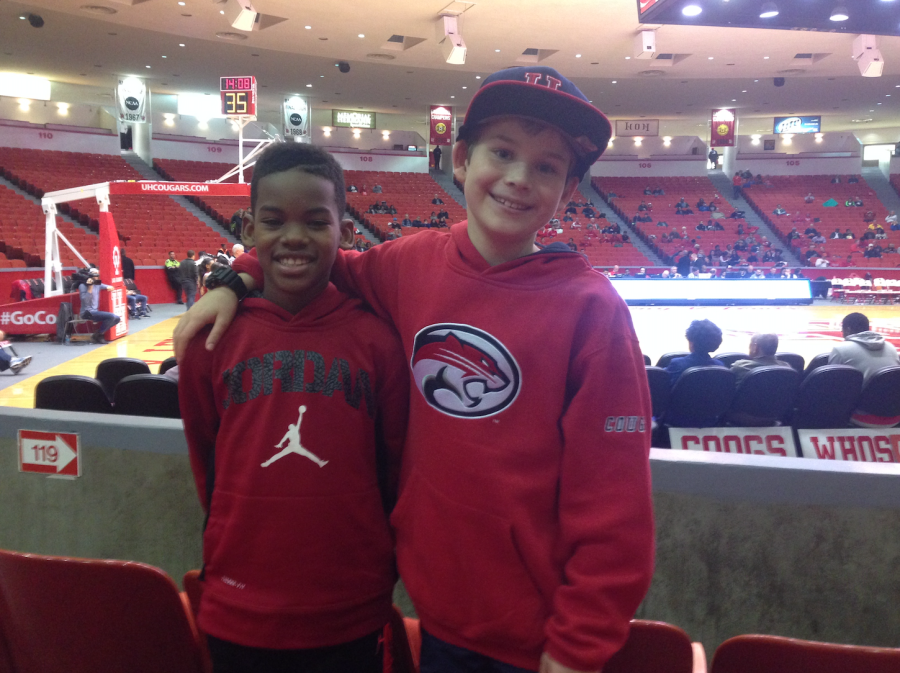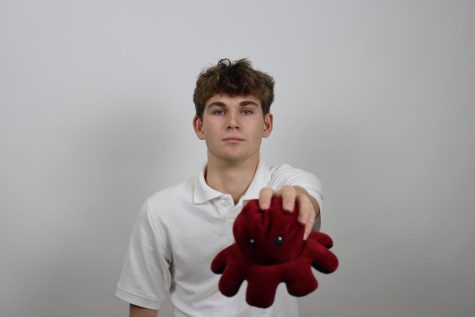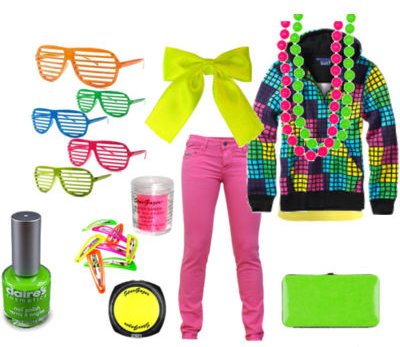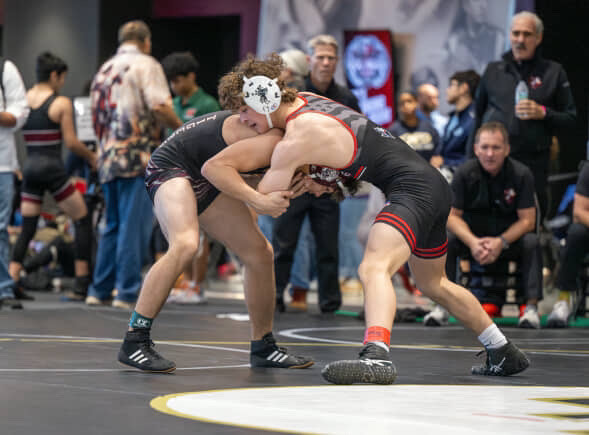The Houston Cougars are as good as they’ve ever been. Here’s why you should care.
Eight-year-old Wilson Bailey attends a Coogs game in the pre-Sampson era. The stadium is noticeably empty.
Ten years ago, I spent 18 home games as a ball boy for the Houston Cougars basketball team. I stood behind the basket, manning the mop with the cracked and peeling University of Houston logo, frenetically wiping down random parts of the scuffed hardwood. Sometimes the ref would point out the spot where a sweaty player had left a smudge or the leaky roof dripped.
I might have only been a mopper, but for my efforts, I got the best seats at Hofheinz Pavilion, right next to half a dozen of the program’s biggest boosters.
I’d look back to the first row and see my parents drowning in a sea of Cougar red, the color coming from the faded seat backs that marked another empty house. They had accompanied me through the players’ tunnel with comped tickets.
The official seating capacity at Hofheinz was listed as 7,100. The attendance was usually announced as 2,500, but only about 500 of the season-ticket holders and students would show: a partial sellout.
At the time, I couldn’t grasp the sadness of it all—that the program boasting five Final Four appearances and that had once captured the nation’s attention during the heyday of the Phi Slama Jama era (1982-1984) was now losing to Prairie View A&M in a dilapidated stadium in front of checked-out fans.
On that day, the loudest cheers came during a pre-game video that showed 1980s stars Hakeem “The Dream” Olajuwon and Clyde “The Glide” Drexler fly higher than anyone could in their era. The Coogs lost that game, 81-80, but 8-year-old me was blissfully unaware of the tragedy unfolding around me.
That 2012-13 season was the best of James Dickey’s four-year head coaching tenure: the Coogs actually finished 20-13, going 7-9 in Conference USA, which earned an invitation to the third-tier College Basketball Invitational tournament where they defeated the equally disappointing Texas Longhorns in the first round. A winning record and victory over the slumping Longhorns pointed to a semi-successful season—this was considered good enough.
“Good enough” left the program’s vocabulary two years later when Kelvin Sampson, a once-great coach who had served a five-year ban from the NCAA for recruiting violations, was hired by Houston to rehabilitate the program’s image—and his own, too.
I didn’t think much of Sampson at the time. All I knew was that he was a cheater, that my favorite UH player, Danuel House, had transferred to Texas A&M and that my team was mired in mediocrity.
When the defending national champion Connecticut Huskies came to town in February 2015, Hofheinz Pavilion was half-full. The Coogs won the game, 60-58, in dramatic fashion on two Jherrod Stiggers free throws, the only signature win in another woeful season. The team back then was chock-full of walk-ons and junior college transfers, but there were signs that the program was establishing a winning culture.
By the time the next season came around, the team was oddly good. After a 6-1 start, Hofheinz sold out for the first time in seven years for a matchup with LSU and future NBA star Ben Simmons. Future Cougar icon Rob Gray Jr. scored 31 points while forward Donrad Knowles, who was so opposed to physical play that he earned the nickname “Chicken,” outdueled Simmons on the way to a high-octane 105-98 overtime victory. UH finished 22–10—yet failed to earn an NCAA tournament bid for the 22nd time in 23 years.
As I biked around campus one day that spring, I noticed a new construction site near Hofheinz. Under the leadership of University President Renu Khator, UH was spending $25 million on a sleek new practice facility. It stuck out like a manicured thumb.
Gone were the days of being relegated to practices in the student rec center. Gone was the leaky roof. Gone was the mediocrity.
After a solid 2016–17 season, UH alum (and future Houston Rockets owner) Tillman Fertitta donated $20 million to tear down Hofheinz and build the state-of-the-art Fertita Center, a signal that the times were a-changin’.
Since then, the Coogs have won more games than any program in Division I basketball, save for the Gonzaga Bulldogs. In 2020, they were on track for a top-three seed in the NCAA tournament, but the season-ending pandemic largely kept the team a secret for another year. In the last two seasons the Cougars reached the Final Four and the Elite Eight, respectively. Now, ESPN talking heads shower praise ad nauseam on Coach Sampson and the Coogs.
Now that the facilities and recruits are better and the championship buzz hums louder, Sampson has remained committed to preaching uncompromising physicality. Prima donna recruits get sifted out in favor of hardened underdogs. UH became the No. 1 team in the nation in November, ahead of perennial powerhouses like Kentucky, Duke and North Carolina, all of whom are unranked as of late January.
“We’ve been here for decades. Welcome back,” a fan-made sign at the Feritta Center reads.
Even though the Coogs are routinely garnering national attention, a sizable portion of Houston doesn’t seem to notice.
That could be because we’re a pro sports town—there’s no college team that could possibly carry the weight of the city of Houston like the Astros.
But the Rockets are newly terrible, and the Texans are consistently terrible. And the only collegiate competition, the Rice Owls, must say somewhere in their charter that their athletic teams will be eternally terrible.
I also don’t buy the narrative that we don’t have enough emotional bandwidth to pay attention to UH for two reasons: UT and A&M.
This isn’t the place to litigate football supremacy in Texas (God forbid, TCU even has a stake to claim now). Not only are UH and Baylor better basketball programs than UT and A&M, but they also occupy a higher place in the pecking order in their respective sport than do the esteemed Longhorns and Aggies.
But people in our community continue to resist rooting for the Coogs for all the wrong reasons.
For those in the St. John’s-Kinkaid-Episcopal syndicate, the University of Houston, and by extension the Third Ward neighborhood, is some far-off netherworld that few River Oaks/Memorial/West U students have ever even visited.
Many of my classmates and their parents are even slightly contemptuous whenever someone mentions anything along Scott Street.
Houstonians hold excellence in high esteem—just ask NASA, the Medical Center and Tex-Mex—so it’s surprising that the entire city is not embracing college basketball excellence.
Like it or not, Kelvin Sampson’s squad is the city’s best basketball team (professional or collegiate)—their recent one-point loss to Temple notwithstanding—and will be a popular pick in March Madness pools.
Sampson is even being mentioned for the Texas job, but every Coog and Longhorn knows Sampson has already built something that’s too good and too gritty for burnt orange.
When the Coogs play in the Final Four at NRG Stadium in April, Longhorn fans should stop shouting “Hook ‘Em” into the void and climb aboard the UH bandwagon.
NRG Stadium serves a great soft opening: you won’t have to go outside your geographical comfort zone, you’ll be surrounded by people who can afford Final Four tickets and you might even be able to use your VIP parking spot from Texans games. No promises, though.
It might even be time to find an update for that signed Olajuwon jersey that hangs in your office. Take a risk with Quentin Grimes or Marcus Sasser.
I went to a Wednesday night game two weeks ago, and now, a roster of starry-eyed second-graders perform my old job. I also noticed they’ve stopped showing the Phi Slama Jama hype video because what this team is doing is just as remarkable. These Cougars don’t pride themselves on dunks and style points; their currency comes in offensive rebounds and floor burns.
“We’re changing how the game is being played,” reads the University ad that plays during games. “Again.”















Milkman Dead • Feb 1, 2023 at 8:45 PM
I remember watching the Dream rock his patented Dream shake in the post and Clyde weave down the lane for a poster. I always get nostalgic whenever I think back to those days. I’m glad they can finally fly once again. Thanks for putting things into prospective young Coog.
Sue A. • Feb 1, 2023 at 8:26 PM
Excellent article. Well covered and written. Enjoyed reading this.
Kevin Hromas • Feb 1, 2023 at 4:56 PM
Well said, Wilson … well said! I was at the games in The Hof starting in 2007-2008 and have had season tickets ever since. Sitting about 10 rows up on mid-court, opposite the benches, the place was so empty that the refs could easily hear my help with calling the game (Watch for the moving screen on 23!) and would actually call it the next time down the court because everyone could see it!
Already have 2 seats at mid-court for the Final Four and looking forward to joining the celebration of a UH NATTY!
Arjun Maitra • Jan 31, 2023 at 11:55 PM
great article. cougs winning it all this year im afraid
wouldnt exactly call ben simmons a star though lol.